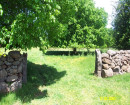MAJOR MITCHELL PLAQUE & Drystone Walls
Summit of Mt Napier BYADUK NORTH, Southern Grampians Shire
-
Add to tour
You must log in to do that.
-
Share
-
Shortlist place
You must log in to do that.
- Download report
Statement of Significance
Major Mitchell's expedition passed nearby this place early in September 1836, when he made several side trips to the summit of Mt Napier in an effort to get bearings and to determine his way forward. Mt Napier was one of the most important places on the expedition. He climbed it on 4th September and his journal entry for that day is extensive.
Monuments and memorials to commemorate Major Mitchell's epic 1836 journey can be found in many locations throughout south western Victoria. The Major crossed Victoria's northern and western plains, found a European settlement already established at Portland, and returned to New South Wales to give a glowing account of the rich land of 'Australia Felix'. One hundred years later, local communities at points along his former route engaged enthusiastically in a bout of centennial monument building. After war memorials, the Mitchell monuments are the most common form of public commemoration in the region. The form of memorial to Major Mitchell at the summit of Mount Napier takes the form of a simple bronze plaque, mounted on a large square concrete base. This is located at the summit of Mount Napier. In the 1840s and 1850s the mountain was an important landmark used to delineate the boundaries of various squatting runs [Mount Napier, Cape Wrath, Brisbane Hill, Lyne, and Old Stockyard (later Banemore). This is evidenced by the construction of drystone walls which meet close to the summit.
How is it significant?
The Major Mitchell Plaque at the summit of Mount Napier of historical significance to the Southern Grampians Shire.
Why is it significant?
The Major Mitchell plaque and drystone walls at the summit of Mount Napier are of historical significance because the plaque commemorates the very beginning of European interest in, occupation of and subsequent exploitation of the further Western District. It is example of the way in which Major Mitchell is revered as a person of extreme importance within the community. The drystone walls are important historically as they signifiy early practices of marking out boundaries in vast landscapes, for vast areas of land. They help us to understand a previous way of life, and the often difficult nature of property ownership in the 1840s and 1850s.
-
-
MAJOR MITCHELL PLAQUE & Drystone Walls - Physical Conditions
The plaque is in good condition and is intact.
MAJOR MITCHELL PLAQUE & Drystone Walls - Physical Description 1
A simple bronze plaque mounted on a low square concrete base on the summit of Mount Napier. The plaque commemorates Major Mitchell's ascent of the mountain in 1836, and reads "In Memory of/ Major Sir Thomas Mitchell/ Explorer of Australia Felix/ Who discovered and named/ Mount Napier/ in August 12th and 28th 1836/ Erected in his honour/ by school children of the district/ Discovery Day 1915".
The plaque was erected by local school children from Byaduk in 1915.MAJOR MITCHELL PLAQUE & Drystone Walls - Historical Australian Themes
Theme 2: Peopling Australia
2.5 Promoting settlement
Theme 3: Developing local, regional and national economies
3.3 Surveying the continent
3.3.1 Looking for inland seas and waterways
3.3.4 Looking for land with agricultural potential
Theme 8: Developing Australia's cultural life
8.7 Honouring achievement
8.9 Commemorating significant eventsMAJOR MITCHELL PLAQUE & Drystone Walls - Usage/Former Usage
Monument
MAJOR MITCHELL PLAQUE & Drystone Walls - Integrity
High degree of integrity
MAJOR MITCHELL PLAQUE & Drystone Walls - Physical Description 2
Major Sir Thomas Livingston Mitchell, Surveyor-General of NSW, explorer and 'discoverer of Australia Felix
Charles McGennisken, proponent of the memorial cairnMAJOR MITCHELL PLAQUE & Drystone Walls - Physical Description 3
Mount Napier State Park
Heritage Study and Grading
Southern Grampians - Southern Grampians Shire Heritage Study
Author: Timothy Hubbard P/L, Annabel Neylon
Year: 2002
Grading:
-
-
-
-
-
MAJOR MITCHELL PLAQUE & Drystone Walls
 Southern Grampians Shire
Southern Grampians Shire
-
-






